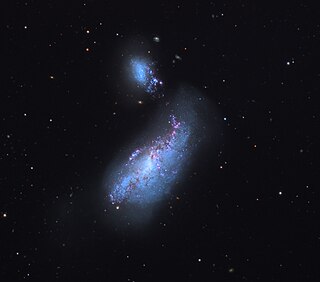
NGC 4490, also known as the Cocoon Galaxy, is a barred spiral galaxy in the constellation Canes Venatici. William Herschel discovered it in 1788. It is known to be of the closest interacting/merging galactic system. The galaxy lies at a distance of 25 million light years from Earth making it located in the local universe. It interacts with its smaller companion NGC 4485 and as a result is a starburst galaxy. NGC 4490 and NGC 4485 are collectively known in the Atlas of Peculiar Galaxies as Arp 269. The two galaxies has already made their closest approach and are rushing away from each other. It's been discovered that NGC 4490 has a double nucleus.

NGC 459, also known as UGC 832, MCG 3-4-17, ZWG 459.24, and PGC 4665, is a spiral galaxy in the constellation Pisces. It was discovered on October 15, 1784, by William Herschel. It was described as being extremely faint by John Dreyer in the New General Catalogue.

NGC 523, also known as Arp 158, from the ARP catalog is a spiral galaxy located in the constellation Andromeda. It was discovered separately by William Herschel on 13 September 1784, and by Heinrich d'Arrest on 13 August 1862. d'Arrest's discovery was listed as NGC 523, while Herschel's was listed as NGC 537; the two are one and the same. John Dreyer noted in the New General Catalogue that NGC 523 is a double nebula.
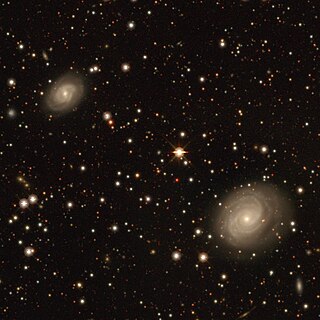
NGC 7042 is a spiral galaxy located about 210 million light-years away in the constellation of Pegasus. NGC 7042 is part of a pair of galaxies that contains the galaxy NGC 7043. Astronomer William Herschel discovered NGC 7042 on October 16, 1784.
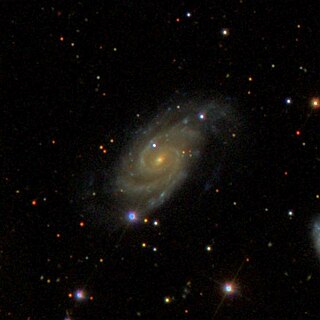
NGC 477 is a spiral galaxy in the constellation Andromeda. It is located approximately 250 million light-years from Earth and was discovered on October 18, 1786 by astronomer William Herschel.
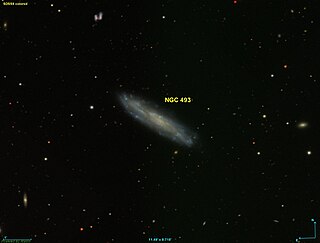
NGC 493, also occasionally referred to as PGC 4979 or GC 281, is a barred spiral galaxy in the constellation Cetus. It is located approximately 90 million light-years from Earth and was discovered on December 20, 1786 by astronomer William Herschel. It was later also observed by his son, John Herschel. John Dreyer, creator of the New General Catalogue, described the galaxy as "very faint, large, much extended 60°" with "a little brighter middle".

NGC 4516 is a barred spiral galaxy located about 55 million light-years away in the constellation Coma Berenices. NGC 4516 was discovered by astronomer William Herschel on April 8, 1784. NGC 4516 is a member of the Virgo Cluster.

NGC 1510 is a dwarf lenticular galaxy approximately 38 million light-years away from Earth in the constellation of Horologium. It was discovered by John Herschel on December 4, 1836.
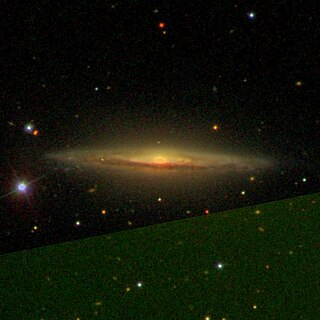
NGC 684 is a spiral galaxy approximately 135 million light-years away from Earth in the constellation of Triangulum. It was discovered by William Herschel on October 26, 1786. Edward Swift, Lewis' son, found this galaxy again on 18 Jan 1890 while "searching for Swift's Comet." and it was reported as a new object in list IX-6.

NGC 1426 is an elliptical galaxy approximately 59 million light-years away from Earth in the constellation of Eridanus. It was discovered by William Herschel in December 9, 1784.

NGC 1199 is an elliptical galaxy approximately 107 million light-years away from Earth in the constellation of Eridanus. It was discovered by William Herschel on December 30, 1785.

NGC 513, also occasionally referred to as PGC 5174 or UGC 953, is a spiral galaxy in the constellation Andromeda. It is located approximately 262 million light-years from the Solar System and was discovered on 13 September 1784 by astronomer William Herschel.
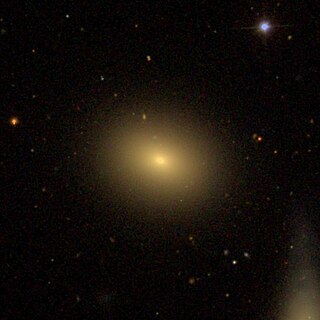
NGC 4551 is an elliptical galaxy located about 70 million light-years away in the constellation Virgo. It was discovered by astronomer William Herschel on April 17, 1784. NGC 4551 appears to lie close to the lenticular galaxy NGC 4550. However, both galaxies show no sign of interaction and have different red shifts. Both galaxies are also members of the Virgo Cluster.

NGC 521, also occasionally referred to as PGC 5190 or UGC 962, is a barred spiral galaxy located approximately 224 million light-years from the Solar System in the constellation Cetus. It was discovered on 8 October 1785 by astronomer William Herschel.

NGC 1293 is an elliptical galaxy located about 215 million light-years away in the constellation Perseus. It was discovered by astronomer William Herschel on October 17, 1786. NGC 1293 is a member of the Perseus Cluster.

NGC 1294 is a lenticular galaxy located about 285 million light-years away in the constellation Perseus. The galaxy was discovered by astronomer William Herschel on October 17, 1786 and is a member of the Perseus Cluster.
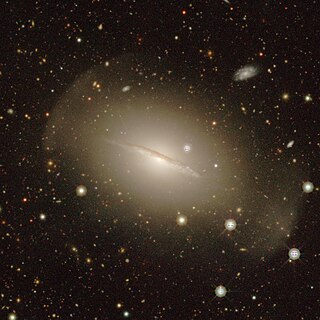
NGC 681 is an intermediate spiral galaxy in the constellation of Cetus, located approximately 66.5 million light-years from Earth. The name Little Sombrero Galaxy is a reference to a much larger and earlier observed sombrero-like galaxy designated M104, or the Sombrero Galaxy.

NGC 1161 is a lenticular galaxy approximately 90 million light-years away from Earth in the constellation of Perseus. It was discovered, along with NGC 1160, by English astronomer William Herschel on October 7, 1784.

NGC 1160 is a spiral galaxy approximately 116 million light-years away from Earth in the constellation of Perseus. It was discovered, along with NGC 1161, by English astronomer William Herschel on October 7, 1784.

NGC 807 is an elliptical galaxy located in the constellation Triangulum. It is listed as part of the New General Catalogue (NGC) of astronomical objects. It was discovered by the astronomer William Herschel on September 11, 1784.




















